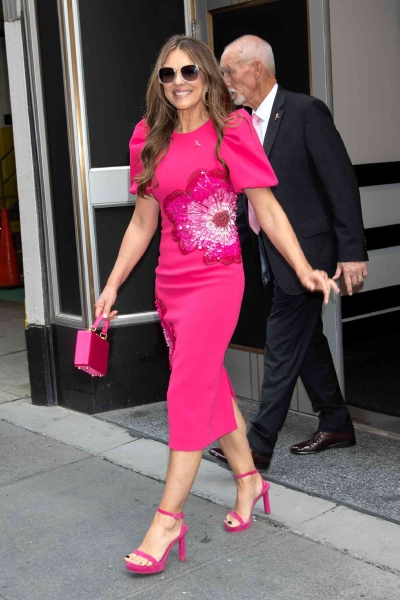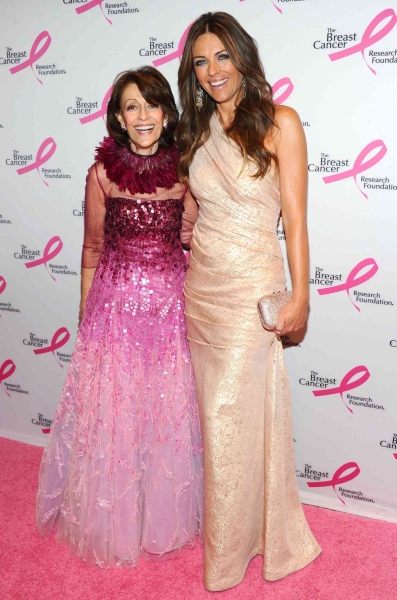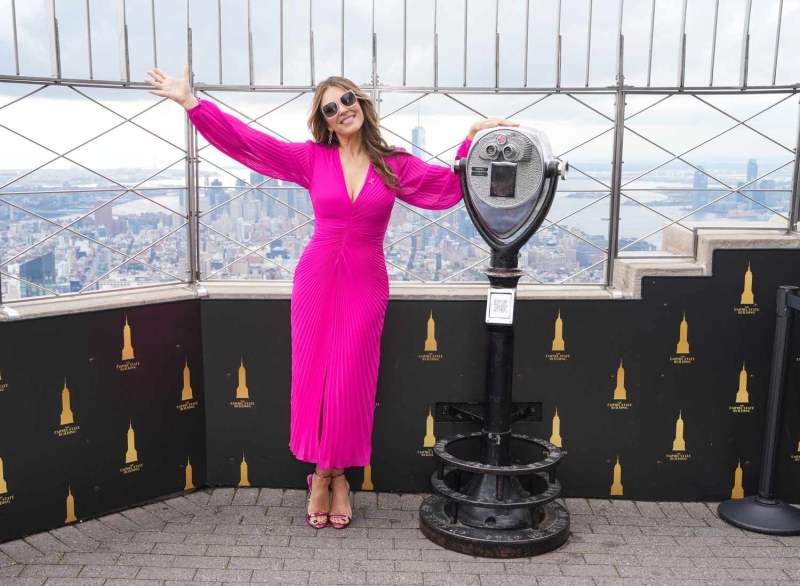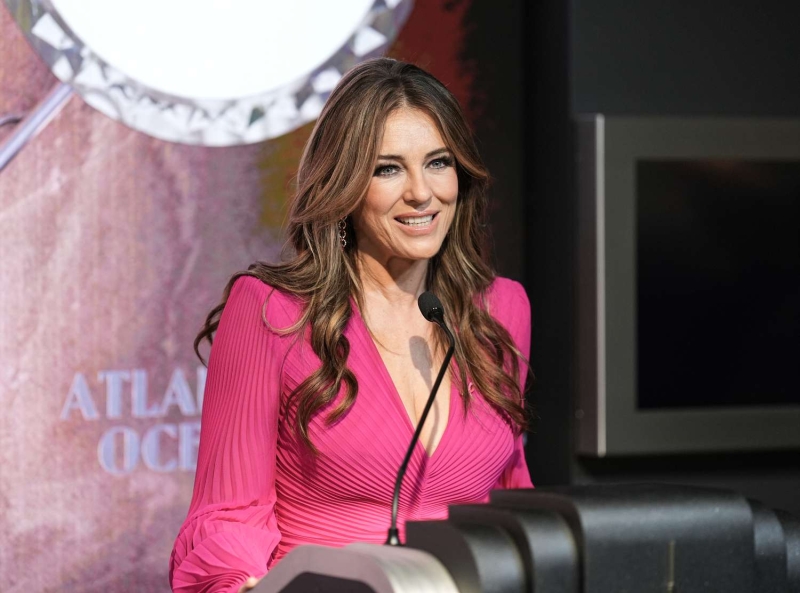Breast care is self care.
In October, Elizabeth Hurley wears pink. And, she started this month, which is also Breast Cancer Awareness month, with a bang.
The Austin Powers star began her morning of interviews on a chilly October 1 in a flamingo-pink button up dress, bedazzled trunk purse, bubblegum-pink hoop earrings, and coordinated wedges. Hours later, she walked into the Empire State Building in a vibrant fuschia cardigan, black skinny jeans, and strappy black heels. Between entering the iconic landmark and reaching its 102nd floor, Hurley swapped her sweater for a pleated long sleeve gown in Barbie-pink, metallic-pink sandals, and pale-pink sunglasses. And after illuminating the skyscraper in a glorious shade of orchid, Hurley had another outfit change. Her last ensemble of the day consisted of a hot pink mididress with puffy short sleeves and two large sequin flowers. A small raspberry-colored purse, matching velvet heels, and a baby-pink breast cancer ribbon pin completed the look, which she wore to boldly ring the bell at the New York Stock Exchange.

“I’m always very proud to wear pink in October,” Hurley tells InStyle, adding that stylist Ann Caruso, who she notes is a “vocal breast cancer survivor,” is responsible for her lively looks. “It’s really important to us that we show that we care about everybody. We’ve made an effort to show solidarity to our survivors and to people who’ve been diagnosed.” In a lovely coincidence, pink is Hurley’s favorite color.
The loud styling matches Hurley’s full-throated support of breast cancer awareness, which has become a way for Hurley to honor her grandmother’s legacy. Her grandmother couldn’t be outspoken about her own diagnosis in the 1970s, and devastatingly passed as a result of the disease in the early ‘90s.
Hurley explains that at that time, no one spoke of breast cancer, and when they did, they did so in hushed tones and with shame. There was no pink ribbon, Breast Cancer Awareness month, open conversations surrounding the disease, substantial research, or advanced treatment.
“I see how things could have been different for her,” she says, adding that her grandmother would be “astonished” by how things have changed. “Now, we do our utmost to share what we know. My grandmother would have had different treatment today.”
The actress, model, and advocate has been using her voice for the cause for nearly 30 years. In 1995, Evelyn Lauder, Estée Lauder’s daughter-in-law, approached Hurley about joining the fledgling Estée Lauder Companies’ Breast Cancer Campaign as its global ambassador. Lauder had founded the campaign in 1992, and co-invented the pink ribbon. Her vision was clear: She told Hurley, “Women all over the world are dying of breast cancer, and nobody is talking about it.” Lauder wanted to change that.

The campaign has since supported more than 60 organizations around the world and funded more than $131 million globally for lifesaving research, education, and medical services, with more than $103 million going toward the Breast Cancer Research Foundation, a nonprofit Lauder founded in 1993. In October 2022, the campaign committed a donation of $15 million over five years to the BCRF to further its goal of reducing breast cancer disparities and improving outcomes in Black women. Breast cancer is the most commonly diagnosed cancer worldwide, with one in eight women in the U.S. developing invasive breast cancer in her lifetime. It is the leading cause of cancer death in women under 50. But the attention and research is working: Mortality rates have decreased by 43 percent among women since the late ‘80s.
Thirteen years after Lauder’s passing, she remains Hurley’s biggest inspiration. “I learned everything I know about breast cancer [from her]. She was a wonderful woman in so many ways, and I really hold her in very high esteem.”
During her tenure as ambassador, Hurley has encouraged women to get their first mammogram at 40 years old and continue to do so each consecutive year. (Hurley was gifted her first mammogram by Lauder.) She advises women to conduct self checks monthly, familiarize themselves with their breasts, see their doctor immediately if they find a lump, and follow guidelines set forth by researchers, such as staying active, eating healthfully, not smoking, and limiting alcohol.
“We tell everybody the information that's at our fingertips. We just hope that people will decide to be proactive and help themselves,” she says. “Breast cancer, if caught early, there's more than a 90 percent chance of survival, because hopefully the cancer hasn't spread. Even though everybody understands that [having your] head in the sand can be a comfort on one level, it just doesn't make sense…Sometimes you have to do what may seem to you the harder thing to take care of yourself.”

Above all, Hurley urges the world to never stop talking about breast cancer, because these conversations can save lives. She recalls a time a few years ago when a friend saw an Instagram post from the campaign and decided to do a self check; she found a lump. She sought medical attention and thanked Hurley for making the post.
“My favorite part always is when we meet people who have been diagnosed and are going through treatment, and we talk to them and hear their stories. Sometimes the stories are very uncomfortable to listen to, but that's why we're here,” Hurley says. “Even though it can be quite painful talking to people, it's pain that we welcome, because we really hope that'll help instigate change.”
Hurley declares, the bottom line is: Breast care is self care—the theme of this year’s campaign.
The Bedazzled star’s self care practices (in addition to regularly checking her breasts) include eating as healthfully as possible, taking nature walks, taking a bath, and even clipping the bushes in her yard—whatever can get her to de-stress. She also prioritizes “listening to some lovely music.” Her tunes of choice? Whale and rainforest sounds, she admits with a laugh.
Fronting this partnership is another thing that brings Hurley peace and optimism. “There are such good things that have come out of this campaign,” she says. “We know how important it is that the researchers keep going, so that every year we can have some hopeful messages.”
